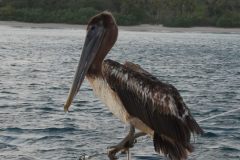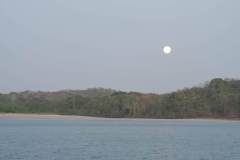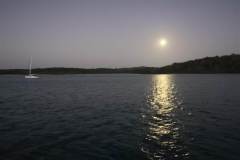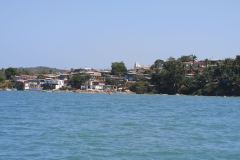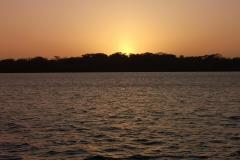We motored SE towards Las Perlas, amazed at the number of ships at anchor waiting transit, and also the large number of tuna boats (Barracuda would pass close to some of these massive fleets en route to the Marquesas). Our first week in the Pacific was to be fairly easy, as there was not a great deal of wind. We motored into the gap between Chapera and Mogo Mogo islands in mid-afternoon. We tucked in close to Chapera to get out of the tide and had a swim in the clear water. We then explored the beaches on both islands, which had beautiful sand, with nobody on them. (Chapera is used for the “Survivor” TV series)
The next day we started out under sail, but turned on the engine after a few hours due to the lack of wind. Our anchorage for the night was on the southern end of San Jose Island. We were out of the prevailing wind, but there was a good swell from the south, with waves crashing onto the beach. We had read about a cave that you could take the dinghy into, but the swell made this impossible. Later in the evening we had a visit from a friendly pelican.
We had a good sail over to the anchorage at Playa de Cacique, on the south side of Isla del Rey. Our plan was to explore the Rio Cacique. We had an exciting ride with the breakers over the bar at the river mouth and then motored slowly upstream. This was real jungle exploration through the mangrove swamp, keeping to the channel, but still having to work our way round fallen branches. Occasionally there would be a loud crash from some animal moving through the mangroves. We stopped the engine and drifted back down stream on the falling tide. There was another exciting moment getting back over the bar and then it was time for a swim and drinks.
There was an early start on Saturday morning, motoring all the way up the east side of the island. We spotted a telecoms tower above San Miguel on the north coast, so had a swift change of direction to enable us to access the internet and emails while we had lunch at anchor. In the afternoon the Angus and Kate fishing competition finally resulted in the capture of a large bonito. Angus spotted the fish on Kates’s line, so it was agreed to split the honours. We headed into a sheltered bay on Casaya Island. The entrance (on the chart) appeared to be a straight run in from the east, but as we got nearer, we could see the reef extending further south. Google Earth confirmed the extent of the reef, and we headed in, pulling up the centreboard to tuck in beside Ampon Island, and out of the swell. We woke to find a fishing net wrapped round both anchor chain and rudder. The fishermen were about a kilometre away, and slowly approached, hauling in their net. They quickly retrieved their net and moved on, accompanied by lots of pelicans. The men had caught at least one large tuna for their efforts. It was low tide (we had 50cm under the hull), and the limits of the reef were clear as we headed back out and turned north. We motored back to our first anchorage off Chapera for another snorkel, and then continued to Contadora Island, where there was to be a cocktail reception and dinner for the World ARC fleet. The fleet would be setting off for the Galapagos in a couple of days, and then on to the South Pacific Islands. Barracuda would be setting their own, much slower, pace. It was time to say goodbye to all the friends we had made. The next day we motored back to Panama City, practising our sextant work on the way, and discovering that if it’s a bit hazy, it’s impossible to differentiate sea from sky! Good news – the repaired mainsail was waiting for us. A night in the marina, and I then jumped in a taxi for my flight back to the UK.
Postscript
The World ARC fleet visited the Galapagos and were on their way to the Marquesas (French Polynesia) when the quarantine rules came into force. Most of the yachts ended up in Tahiti, with the crews flying home, and World ARC cancelled and delayed for a year; one US yacht went to Hawaii. Graham and Kate were in the middle of a crew change in the Galapagos when lock down started. Angus got home OK, one new crew member got as far as Peru before having to return to the UK, another couple did get to the boat, and so Kate decided to stay rather than attempt to fly home. After weeks of lock down in the Galapagos they sailed for the Marquesas, having been assured that they would be allowed entry. They arrived there just as the quarantine restrictions were lifted, and are now working their way through the Marquesas and Tuamotu Islands, before heading for Tahiti.
Max elevation: 55 m
Total climbing: 475 m
